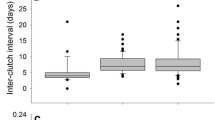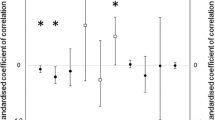Abstract
Most data on determinants of reproductive success (RS) and reproductive “tactics” are correlational in nature, and hence cannot be used to infer causation. Consistent patterns-such as an increase in RS with age, as seen in many types of organisms-may result from diverse underlying mechanisms. Ontogenetic increases in RS in mammals and birds may be due largely to direct effects of age (via learning, etc.) but our analyses show that apparently analogous ontogenetic shifts in reproductive tactics and increases in RS in sand lizards (Lacerta agilis) are actually due to ontogenetic changes in body size. When size effects are removed, age exerts very little effect on either reproductive behaviour or RS in either sex. In many taxa, both age and body size may exert important effects on reproductive biology, and disentangling these effects should be a focus of further research.
Similar content being viewed by others
References
Altmann J (1974) Observational study of behavior: sampling methods. Behavior 49:227–267
Andrews R (1982) Patterns of growth in reptiles. In: Gans C, Pough FH (eds) Biology of the reptilia, vol 13. (Physiology D, Physiological ecology) Academic Press, London, pp 273–320
Bischoff W (1984) Lacerta agilis (Linnaeus 1758) — Zauneidechse. In: Böhme W (ed) Handbuch der Reptilien und Amphibien Europas. Band II/I, Echsen II, AULA, Wiesbaden, Germany, pp 26–38
Burghardt GM (1977) Learning processes in reptiles. In: Gans C, Tinkle DW (eds) Biology of the reptilia, vol 7. Academic Press, London, pp 555–684
Clutton Brock TH (ed) (1988) Reproductive success: studies of individual variation in contrasting breeding systems. The University of Chicago Press, Chicago
Elgar MA, Pierce NE (1988) Mating success and fecundity in an ant-tended Lycaenid butterfly. In: Clutton Brock TH (ed) Reproductive success: studies of individual variation in contrasting breeding systems. The Univesity of Chicago Press, Chicago, pp 59–75
Fitch H (1975) A demographic study of the Ringneck Snake (Diadophis punctatus) in Kansas. Museum of Natural History Miscellaneous Publications No 62. University of Kansas
Fitzpatrick JW, Woolfenden GE (1988) Components of lifetime reproductive success in the Florida scrub jay. In: Clutton Brock TH (ed) Reproductive success: studies of individual variation in contrasting breeding systems. The University of Chicago Press, Chicago, pp 305–320
Harvey PH, Stenning MJ, Campbell B (1988) Factors influencing reproductive success in the Pied Flycatcher. In: Clutton Brock TH (ed) Reproductive success: studies of individual variation in contrasting breeding systems. The University of Chicago Press, Chicago, pp 189–200
Hemelaar A (1985) An improved method to estimate the number of year rings resorbed in the phalanges of Bufo bufo (L.) and its application to populations from different latitudes and altitudes. Amphibia Reptilia 6:323–341
Hews D (1990) Examining hypotheses generated by field measures of sexual selection on male lizards, Uta palmeri. Evolution 44:1967–1977
Howard R (1988) Reproductive success in two species of amphibians. In: Clutton Brock TH (ed) Reproductive success: studies of individual variation in contrasting breeding systems. University of Chicago Press, Chicago, pp 99–118
Jennrich IR, Turner BF (1969) Measurement of non-circular home ranges. J Theor Biol 22:227–237
Kruijt JP, de Vos GJ (1988) Individual variation in reproductive success in male Black Grouse, Tetrao tetrix. In: Clutton Brock TH (ed) Reproductive success: studies of individual variation in contrasting breeding systems. University of Chicago Press, Chicago, pp 279–290
McCleery RH, Perrins CM (1988) Lifetime reproductive success in the Great Tit, Parus major. In: Clutton Brock TH (ed) Reproductive success: studies of individual variation in contrasting breeding systems. University of Chicago Press, Chicago, pp 136–153
Madsen T, Shine R, Loman J, Håkansson T (1993) Determinants of mating success in male adders, Vipera berus. Anim Behav 45:491–499
Newton I (1988) Age and reproduction in the Sparrowhawk. In: Clutton Brock TH (ed) Reproductive success: studies of individual variation in contrasting breeding systems. University of Chicago Press, Chicago, pp 201–229
Ollason JC, Dunnett GM (1988) Variation and breeding success in Fulmars. In: Clutton Brock TH (ed) Reproductive success: studies of individual variation in contrasting breeding systems. University of Chicago Press, Chicago, pp 263–278
Olsson M (1992) Sexual selection and reproductive strategies in the sand lizard, Lacerta agilis. PhD thesis, University of Göteborg, Sweden
Olsson M (1993) Male choice for large females and assortative mating for body size in the sand lizard, Lacerta agilis. Behav Ecol Sociobiol 32:337–341
Olsson M (1994) Nuptial coloration in the sand lizard, Lacerta agilis: an intra-sexually selected cue to fighting ability. Anim Behav 48: 607–613
SAS (1987) SAS/STAT guide for personal computers, version 6. SAS Institute, Cary, NC
Shine R (1992) Relative clutch mass and body shape in lizards and snakes: is reproductive investment constrained or optimized? Evolution 46:828–833
Smith JNM (1988) Determinants of lifetime reproductive success in the song sparrow. In: Clutton Brock TH (ed) Reproductive success: studies of individual variation in contrasting breeding systems. University of Chicago Press, Chicago, pp 154–172
Thomas CS, Coulson JC (1988) Reproductive success of Kittiwake Gulls, Rissa tridactyla. In: Clutton Brock TH (ed) Reproductive success: studies of individual variation in contrasting breeding systems. University of Chicago Press, Chicago, pp 251–262
Trivers R (1976) Sexual selection and resource-accruing abilities in Anolis garmani. Evolution 30:253–269
Author information
Authors and Affiliations
Rights and permissions
About this article
Cite this article
Olsson, M., Shine, R. Does reproductive success increase with age or with size in species with indeterminate growth? A case study using sand lizards (Lacerta agilis). Oecologia 105, 175–178 (1996). https://doi.org/10.1007/BF00328543
Received:
Accepted:
Issue Date:
DOI: https://doi.org/10.1007/BF00328543




